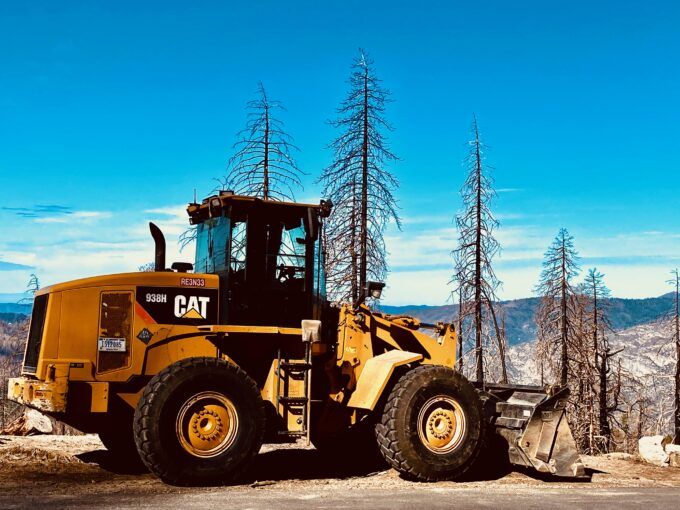by Lisa Song, Illustrations by Max Gunther, special to ProPublica
Last year, I became obsessed with a plastic cup.
It was a small container that held diced fruit, the type thrown into lunch boxes. And it was the first product I’d seen born of what’s being touted as a cure for a crisis.
Plastic doesn’t break down in nature. If you turned all of what’s been made into cling wrap, it would cover every inch of the globe. It’s piling up, leaching into our water and poisoning our bodies.
Scientists say the key to fixing this is to make less of it; the world churns out 430 million metric tons each year.
But businesses that rely on plastic production, like fossil fuel and chemical companies, have worked since the 1980s to spin the pollution as a failure of waste management — one that can be solved with recycling.
Industry leaders knew then what we know now: Traditional recycling would barely put a dent in the trash heap. It’s hard to transform flimsy candy wrappers into sandwich bags, or to make containers that once held motor oil clean enough for milk.
Now, the industry is heralding nothing short of a miracle: an “advanced”type of recycling known as pyrolysis — “pyro” means fire and “lysis” means separation. It uses heat to break plastic all the way down to its molecular building blocks.
While old-school, “mechanical” recycling yields plastic that’s degraded or contaminated, this type of “chemical” recycling promises plastic that behaves like it’s new, and could usher in what the industry casts as a green revolution: Not only would it save hard-to-recycle plastics like frozen food wrappers from the dumpster, but it would turn them into new products that can replace the old ones and be chemically recycled again and again.
So when three companies used ExxonMobil’s pyrolysis-based technology to successfully conjure up that fruit cup, they announced it to the world.
“This is a significant milestone,” said Printpack, which turned the plastic into cups. The fruit supplier Pacific Coast Producers called it “the most important initiative a consumer-packaged goods company can pursue.”
“ExxonMobil is supporting the circularity of plastics,” the August 2023 news release said, citing a buzzword that implies an infinite loop of using, recycling and reusing.
They were so proud, I hoped they would tell me all about how they made the cup, how many of them existed and where I could buy one.
So began my long — and, well, circular — pursuit of the truth at a time when it really matters.
This year, nearly all of the world’s countries are hammering out a United Nations treaty to deal with the plastic crisis. As they consider limiting production, the industry is making a hard push to shift the conversation to the wonders of chemical recycling. It’s also buying ads during cable news shows as U.S. states consider laws to limit plastic packaging and lobbying federal agencies to loosen the very definition of what it means to recycle.
It’s been selling governments on chemical recycling, with quite a bit of success. American and European regulators have spent tens of millions subsidizing pyrolysis facilities. Half of all U.S. states have eased air pollution rules for the process, which has been found to release carcinogens like benzene and dioxins and give off more greenhouse gases than making plastic from crude oil.
Given the high stakes of this moment, I set out to understand exactly what the world is getting out of this recycling technology. For months, I tracked press releases, interviewed experts, tried to buy plastic made via pyrolysis and learned more than I ever wanted to know about the science of recycled molecules.
Under all the math and engineering, I found an inconvenient truth: Not much is being recycled at all, nor is pyrolysis capable of curbing the plastic crisis.
Not now. Maybe not ever.
Let’s take a closer look at that Printpack press release, which uses convoluted terms to describe the recycled plastic in that fruit cup:
“30% ISCC PLUS certified-circular”
“mass balance free attribution”
It’s easy to conclude the cup was made with 30% recycled plastic — until you break down the numerical sleight of hand that props up that number.
It took interviews with a dozen academics, consultants, environmentalists and engineers to help me do just that.
Stick with me as I unravel it all.
Lesson 1: Most of the old plastic that goes *into* pyrolysis doesn’t actually become new plastic.
In traditional recycling, plastic is turned into tiny pellets or flakes, which you can melt again and mold back into recycled plastic products.
Even in a real-life scenario, where bottles have labels and a little bit of juice left in them, most of the plastic products that go into the process find new life.
The numbers are much lower for pyrolysis.
It’s “very, very, very, very difficult” to break down plastic that way, said Steve Jenkins, vice president of chemicals consulting at Wood Mackenzie, an energy and resources analytics firm. “The laws of nature and the laws of physics are trying to stop you.”
Waste is heated until it turns into oil. Part of that oil is composed of a liquid called naphtha, which is essential for making plastic.
There are two ingredients in the naphtha that recyclers want to isolate: propylene and ethylene — gases that can be turned into solid plastics.
To split the naphtha into different chemicals, it’s fed into a machine called a steam cracker. Less than half of what it spits out becomes propylene and ethylene.
This means that if a pyrolysis operator started with 100 pounds of plastic waste, it can expect to end up with 15-20 pounds of reusable plastic. Experts told me the process can yield less if the plastic used is dirty or more if the technology is particularly advanced.
I reached out to several companies to ask how much new plastic their processes actually yield, and none provided numbers. The American Chemistry Council, the nation’s largest plastic lobby, told me that because so many factors impact a company’s yield, it’s impossible to estimate that number for the entire industry.
Lesson 2: The plastic that comes *out of* pyrolysis contains very little recycled material.
With mechanical recycling, it’s hard to make plastic that’s 100% recycled; it’s expensive to do, and the process degrades plastic. Recycled pellets are often combined with new pellets to make stuff that’s 25% or 50% recycled, for example.
But far less recycled plastic winds up in products made through pyrolysis.
That’s because the naphtha created using recycled plastic is contaminated. Manufacturers add all kinds of chemicals to make products bend or keep them from degrading in the sun.
Recyclers can overpower them by heavily diluting the recycled naphtha. With what, you ask? Nonrecycled naphtha made from ordinary crude oil!
This is the quiet — and convenient — part of the industry’s revolutionary pyrolysis method: It relies heavily on extracting fossil fuels. At least 90% of the naphtha used in pyrolysis is fossil fuel naphtha. Only then can it be poured into the steam cracker to separate the chemicals that make plastic.
So at the end of the day, nothing that comes out of pyrolysis physically contains more than 10% recycled material (though experts and studies have shown that, in practice, it’s more like 5% or 2%).
Lesson 3: The industry uses mathematical acrobatics to make pyrolysis look like a success.
Ten percent doesn’t look very impressive. Some consumers are willing to pay a premium for sustainability, so companies use a form of accounting called mass balance to inflate the recycled-ness of their products. It’s not unlike offset schemes I’ve uncovered that absolve refineries of their carbon emissions and enable mining companies to kill chimpanzees. Industry-affiliated groups like the International Sustainability and Carbon Certification write the rules. (ISCC didn’t respond to requests for comment.)
To see how this works, let’s take a look at what might happen to a batch of recycled naphtha. Let’s say the steam cracker splits the batch into 100 pounds of assorted ingredients.
You’ll get some colorless gasses that are used to make plastic: 13 pounds of propylene and 30 pounds of ethylene. You’ll also wind up with 57 pounds of other chemicals.
Propylene makes sturdy material such as butter tubs; ethylene makes flexible plastics like yogurt pouches. Many of the other chemicals aren’t used to make plastic — some get used to make rubber and paint or are used as fuel.
All of these outputs are technically 10% recycled, since they were made from 10% recycled naphtha. (I’m using this optimistic hypothetical to make the math easy.)
But companies can do a number shuffle to assign all of the recycled value from the butter tubs to the yogurt pouches.
Watch video ➜
That way they can market the yogurt pouches as 14% recycled (or “circular”), even though nothing has physically changed about the makeup of the pouches.
Watch video ➜
What’s more, through a method called free attribution, companies can assign the recycled value from other chemicals (even if they would never be turned into plastic) to the yogurt pouches.
Watch video ➜
Now, the yogurt pouches can be sold as 33% recycled.
Watch video ➜
There are many flavors of this kind of accounting. Another version of free attribution would allow the company to take that entire 30-pound batch of “33% recycled” pouches and split them even further:
A third of them, 10 pounds, could be labeled 100% recycled — shifting the value of the full batch onto them — so long as the remaining 20 pounds aren’t labeled as recycled at all.
As long as you avoid double counting, Jenkins told me, you can attribute the full value of recycled naphtha to the products that will make the most money. Companies need that financial incentive to recoup the costs of pyrolysis, he said.
But it’s hard to argue that this type of marketing is transparent. Consumers aren’t going to parse through the caveats of a 33% recycled claim or understand how the green technology they’re being sold perpetuates the fossil fuel industry. I posed the critiques to the industry, including environmentalists’ accusations that mass balance is just a fancy way of greenwashing.
The American Chemistry Council told me it’s impossible to know whether a particular ethylene molecule comes from pyrolysis naphtha or fossil fuel naphtha; the compounds produced are “fungible” and can be used for multiple products, like making rubber, solvents and paints that would reduce the amount of new fossil fuels needed. Its statement called mass balance a “well-known methodology” that’s been used by other industries including fair trade coffee, chocolate and renewable energy.
Legislation in the European Union already forbids free attribution, and leaders are debating whether to allow other forms of mass balance. U.S. regulation is far behind that, but as the Federal Trade Commission revises its general guidelines for green marketing, the industry is arguing that mass balance is crucial to the future of advanced recycling. “The science of advanced recycling simply does not support any other approach because the ability to track individual molecules does not readily exist,” said a comment from ExxonMobil.
If you think navigating the ins and outs of pyrolysis is hard, try getting your hands on actual plastic made through it.
It’s not as easy as going to the grocery store. Those water bottles you might see with 100% recycled claims are almost certainly made through traditional recycling. The biggest giveaway is that the labels don’t contain the asterisks or fine print typical of products made through pyrolysis, like “mass balance,” “circular” or “certified.”
When I asked about the fruit cup, ExxonMobil directed me to its partners. Printpack didn’t respond to my inquiries. Pacific Coast Producers told me it was “engaged in a small pilot pack of plastic bowls that contain post-consumer content with materials certified” by third parties, and that it “has made no label claims regarding these cups and is evaluating their use.”
I pressed the American Chemistry Council for other examples.
“Chemical recycling is a proven technology that is already manufacturing products, conserving natural resources, and offering the potential to dramatically improve recycling rates,” said Matthew Kastner, a media relations director. His colleague added that much of the plastic made via pyrolysis is “being used for food- and medical-grade packaging, oftentimes not branded.”
They provided links to products including a Chevron Phillips Chemical announcement about bringing recycled plastic food wrapping to retail stores.
“For competitive reasons,” a Chevron spokesperson declined to discuss brand names, the product’s availability or the amount produced.
In another case, a grocery store chain sold chicken wrapped in plastic made by ExxonMobil’s pyrolysis process. The producers told me they were part of a small project that’s now discontinued.
In the end, I ran down half a dozen claims about products that came out of pyrolysis; each either existed in limited quantities or had its recycled-ness obscured with mass balance caveats.
Then this April, nearly eight months after I’d begun my pursuit, I could barely contain myself when I got my hands on an actual product.
I was at a United Nations treaty negotiation in Ottawa, Ontario, and an industry group had set up a nearby showcase. On display was a case of Heinz baked beans, packaged in “39% recycled plastic*.” (The asterisk took me down an online rabbit hole about certification and circularity. Heinz didn’t respond to my questions.)
This, too, was part of an old trial. The beans were expired.
Pyrolysis is a “fairy tale,” I heard from Neil Tangri, the science and policy director at the environmental justice network Global Alliance for Incinerator Alternatives. He said he’s been hearing pyrolysis claims since the ’90s but has yet to see proof it works as promised.
“If anyone has cracked the code for a large-scale, efficient and profitable way to turn plastic into plastic,” he said, “every reporter in the world” would get a tour.
If I did get a tour, I wondered, would I even see all of that stubborn, dirty plastic they were supposedly recycling?
The industry’s marketing implied we could soon toss sandwich bags and string cheese wrappers into curbside recycling bins, where they would be diverted to pyrolysis plants. But I grew skeptical as I watched a webinar for ExxonMobil’s pyrolysis-based technology, the kind used to make the fruit cup. The company showed photos of plastic packaging and oil field equipment as examples of its starting material but then mentioned something that made me sit up straight: It was using pre-consumer plastic to “give consistency” to the waste stream.
Chemical plants need consistency, so it’s easier to use plastic that hasn’t been gunked up by consumer use, Jenkins explained.
But plastic waste that had never been touched by consumers, such as industrial scrap found at the edges of factory molds, could easily be recycled the old-fashioned way. Didn’t that negate the need for this more polluting, less efficient process?
I asked ExxonMobil how much post-consumer plastic it was actually using. Catie Tuley, a media relations adviser, said it depends on what’s available. “At the end of the day, advanced recycling allows us to divert plastic waste from landfills and give new life to plastic waste.”
I posed the same question to several other operators. A company in Europe told me it uses “mixed post-consumer, flexible plastic waste” and does not recycle pre-consumer waste.
But this spring at an environmental journalism conference, an American Chemistry Council executive confirmed the industry’s preference for clean plastic as he talked about an Atlanta-based company and its pyrolysis process. My colleague Sharon Lerner asked whether it was sourcing curbside-recycled plastic for pyrolysis.
If Nexus Circular had a “magic wand,” it would, he acknowledged, but right now that kind of waste “isn’t good enough.” He added, “It’s got tomatoes in it.”
(Nexus later confirmed that most of the plastic it used was pre-consumer and about a third was post-consumer, including motor oil containers sourced from car repair shops and bags dropped off at special recycling centers.)
Clean, well-sorted plastic is a valuable commodity. If the chemical recycling industry grows, experts told me, those companies could end up competing with the far more efficient traditional recycling.
To spur that growth, the American Chemistry Council is lobbying for mandates that would require more recycled plastic in packaging; it wants to make sure that chemically recycled plastic counts. “This would create market-driven demand signals,” Kastner told me, and ease the way for large-scale investment in new chemical recycling plants.
I asked Jenkins, the energy industry analyst, to play out this scenario on a larger scale.
Were all of these projects adding up? Could the industry conceivably make enough propylene and ethylene through pyrolysis to replace much of our demand for new plastic?
He looked three years into the future, using his company’s latest figures on global pyrolysis investment, and gave an optimistic assessment.
At best, the world could replace 0.2% of new plastic churned out in a year with products made through pyrolysis.
About the Math
Our article is focused on pyrolysis because it’s the most popular form of chemical recycling. Other types of chemical recycling technologies have their own strengths and weaknesses.
There are different variations of pyrolysis, and steam crackers produce a range of ethylene and propylene yields. Companies are secretive about their operations. To estimate the efficiencies of pyrolysis and mass balance, I read dozens of peer-reviewed studies, reports, industry presentations, advertisements and news stories. I also fact checked with a dozen experts who have different opinions on pyrolysis, mass balance and recycling. Some of them, including Jenkins and Anthony Schiavo, senior director at Lux Research, provided estimates of overall yields for companies trying to make plastic. All of that information coalesced around a 15% to 20% yield for conventional pyrolysis processes and 25% to 30% for more advanced technologies. We are showcasing the conventional process because it’s the most common scenario.
We took steps to simplify the math and jargon. For instance, we skipped over the fact that a small amount of the naphtha fed into the steam cracker is consumed as fuel. And we called the fraction of pyrolysis oil that’s suitable for a steam cracker “pyrolysis naphtha”; it is technically a naphtha-like product.
These processes may improve over time as new technologies are developed. But there are hard limits and tradeoffs associated with the nature of steam cracking, the contamination in the feedstock, the type of feedstock used and financial and energy costs.
Graphics and development by Lucas Waldron. Design and development by Anna Donlan. Mollie Simon and Gabriel Sandoval contributed research.
This content originally appeared on ProPublica and was authored by by Lisa Song, Illustrations by Max Gunther, special to ProPublica.
This post was originally published on Radio Free.

 Unsplash
Unsplash Unsplash
Unsplash



.jpg) Unsplash
Unsplash







 ?
?


 (@Bottoms_bray)
(@Bottoms_bray) 







 We were joined by a packed house of passionate campaigners, residents and voters who had an energetic debate about how we address the most existential threat of our times:
We were joined by a packed house of passionate campaigners, residents and voters who had an energetic debate about how we address the most existential threat of our times:




 Over 80,000 people, all marching to Parliament with one message for our politicians:
Over 80,000 people, all marching to Parliament with one message for our politicians: 
 Trail hunting banned
Trail hunting banned
 it made me think on this
it made me think on this 

